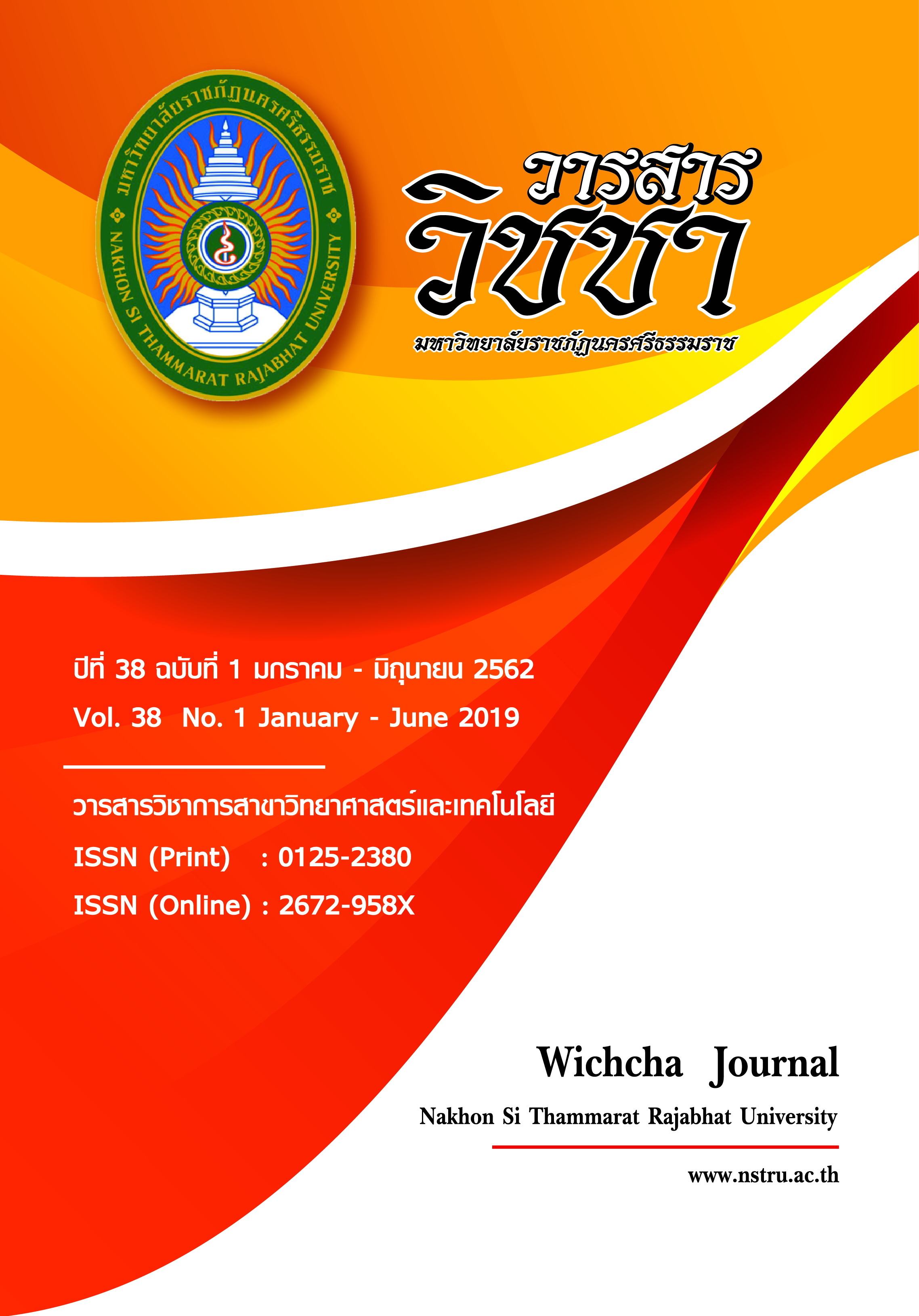Isolation and Screening of Bacterial Antagonistic for Controlling Aspergillus flavus การคัดแยกและคัดเลือกเชื้อแบคทีเรียปฏิปักษ์ในการควบคุมเชื้อรา Aspergillus flavus
Main Article Content
Abstract
Antagonist bacteria were isolated from soil for determination of antifungal potential. Antagonistic activities of 48 isolates on Aspergillus flavus were evaluated by dual culture technique. The results indicated that 5 isolates, IKPS 4, IKPS 27, IKPS 36, IKPS 42 and IKPS 46 exhibited the highest antifungal activities, which was isolate IKPS 4 gave the highest activity at 56.67±8.819%. Isolate IKPS 4 was identified as Bacillus sp. The best condition of antifungal substance production was optimized for 96 hrs at pH 7.0, 30 oC. The poisoned food method was conducted to evaluate antifungal activity of the bacterial culture supernatant. At the concentration of 100% supernatant, the highest antifungal activity (65.01±15.28%) was observed. Morphology of A. flavus under light microscope indicated that the effected mycelium was smaller and shorter than unaffected mycelium. Growth inhibition of fungal on seeds were conducted by dip coating method. The seeds coated with the culture supernatant at 100 and 50.00% concentrations had the highest fungal growth inhibition at 3 days.
Article Details
เนื้อหาและข้อมูลในบทความที่ลงตีพิมพ์ในวารสารวิชชา มหาวิทยาลัยราชภัฏนครศรีธรรมราช ถือเป็นข้อคิดเห็นและความรับผิดชอบของผู้เขียนบทความโดยตรง ซึ่งกองบรรณาธิการวารสารไม่จำเป็นต้องเห็นด้วยหรือร่วมรับผิดชอบใด ๆ
บทความ ข้อมูล เนื้อหา รูปภาพ ฯลฯ ที่ได้รับการตีพิมพ์ในวารสารวิชชา มหาวิทยาลัยราชภัฏนครศรีธรรมราช ถือเป็นลิขสิทธ์ของวารสารวิชชา มหาวิทยาลัยราชภัฏนครศรีธรรมราช หากบุคคลหรือหน่วยงานใดต้องการนำข้อมูลทั้งหมดหรือส่วนหนึ่งส่วนใดไปเผยแพร่ต่อหรือเพื่อการกระทำการใด ๆ จะต้องได้รับอนุญาตเป็นลายลักษณ์อักษรจากวารสารวิชชา มหาวิทยาลัยราชภัฏนครศรีธรรมราชก่อนเท่านั้น
The content and information in the article published in Wichcha journal Nakhon Si Thammarat Rajabhat University, It is the opinion and responsibility of the author of the article. The editorial journals do not need to agree. Or share any responsibility.
References
ชวเลิศ ตรีกรุณาสวัสดิ์ เนตรา สมบูรณ์แก้ว ศุภรา อัคคะสาระกุล สุพี วนศิรากุล ชุติมา วิธูรจิตต์ อัจฉราพร ศรีจุดานุ อารีรัตน์ การุณสถิตชัย และวีรภรณ์ เดชนำบัญชาชัย. (2559). การ
ควบคุมการปนเปื้อนจุลินทรีย์และสารพิษจากเชื้อราในกระบวนการผลิตผลิตผลเกษตรหลัง การเก็บเกี่ยว. รายงานโครงการวิจัย คลังผลงานวิจัย กรมวิชาการเกษตร.
ชาคริยา ฉลาด และสุนันทา ข้องสาย. (2555). จุลินทรีย์และสารพิษอะฟลาทอกซินในอาหารที่ จำหน่ายในจังหวัดตรัง. วารสารวิจัย มหาวิทยาลัยเทคโนโลยีราชมงคลศรีวิชัย, 4(2), 56-69.
เดชาวุฒิ วานิชสรรพ์ นิทัศน์ นิลฉวี ทวีศักดิ์ รัตนคม และพรรณนิการ์ กงจักร. (2558). ขั้นตอนวิธี
นับจำนวนเชื้อบนแผ่นฮิโมชิโตมิเตอร์ด้วยเทคนิคประมวลผลภาพและดีบีสแกน. วารสาร เทคโนโลยีสารสนเทศ, 11(2), 56-61.
นพดล มีมาก และเพชรรัตน์ ศักดินันท์. (2552). อะฟลาทอกซินในอาหารโคนมจากภาคตะวันตกของประเทศไทย. วารสารวิจัย มหาวิทยาลัยเทคโนโลยีราชมงคลศรีวิชัย, 1(1), 20-26.
บุษราคัม อุดมศักดิ์ สุรีย์พร บัวอาจ ณัฏฐิมา โฆษิตเจริญกุล และอมรรัตน์ ภู่ไพบูลย์. (2556). การ
คัดเลือกและทดสอบสายพันธุ์ Bacillus ที่มีศักยภาพในการควบคุมเชื้อรา Phytophthora
parasitica. ใน กลุ่มวิจัยโรคพืช สำนักวิจัยพัฒนาการอารักขาพืช. รายงานผลงานวิจัยประจำปี 2555, หน้า 855-898. กรุงเทพฯ: กรมวิชาการเกษตร.
บัวสาย เพชรสุริยวงศ์ นงพงา คุณจักร และอาภรณ์ วงษ์วิจารณ์. (2555). การแยกและการจัดจำแนก
แบคทีเรียจากดินที่มีฤทธิ์ต้านเชื้อรา. ใน การประชุมทางวิชาการครั้งที่ 50 มหาวิทยาลัยเกษตรศาสตร์: สาขาวิทยาศาสตร์, สาขาทรัพยากรธรรมชาติและสิ่งแวดล้อม (หน้า 124-131). กรุงเทพฯ: มหาวิทยาลัยเกษตรศาสตร์.
ปวีณา สังข์แก้ว เสมอใจ ชื่นจิตต์ และวสันณ์ เพชรรัตน์. (2555). การคัดเลือกและเตรียมสูตรสำเร็จ เชื้อ Streptomyces griseus subsp. formicus เพื่อควบคุมเชื้อรา Rigidoporus microporus สาเหตุโรครากขาวของยางพารา. วารสารวิทยาศาสตร์เกษตร, 43(2)(ฉบับพิเศษ), 21-24.
พฤกษา หล้าวงษา. (2561). จุลินทรีย์ในดิน : แบคทีเรีย. สืบค้นเมื่อ 9 สิงหาคม 2561, จาก: https://ag.kku.ac.th/ land/File cours/1503593761005601.pdf.
วิไลวรรณ ไชยศร. (2560). การคัดเลือกแบคทีเรียละลายฟอสเฟตจากดินและสภาวะที่เหมาะสมต่อ การเจริญและการละลายฟอสเฟต. วารสารวิชชา มหาวิทยาลัยราชภัฏนครศรีธรรมราช, 36(2), 11-24.
หฤทัย ไทยสุชาติ และพรอนันต์ บุญก่อน. (2557). การควบคุมเชื้อราปนเปื้อนในกระเทียมด้วยสาร สกัดจากพืชและจุลินทรีย์ปฏิปักษ์ในสภาพห้องทดลอง. วารสารวิทยาศาสตร์ มข., 42(4), 771-780.
อทิพันธ์ เสียมไหม ฌานิกา แซ่แง่ ชูกลิ่น ปวีณา ดิกิจ และนฤมล มีบุญ. (2561). การประยุกต์ใช้ เปลือกกล้วยเป็นแหล่งคาร์บอนสำหรับการผลิตสารลดแรงตึงผิวชีวภาพจากแบคทีเรียที่ ปนเปื้อนน้ำมันหล่อลื่นเครื่องยนต์ที่ใช้แล้ว. วารสารวิชชา มหาวิทยาลัยราชภัฏนครศรีธรรมราช, 37(ฉบับพิเศษ), 39-53.
อาภากร ศิลป์ประเสริฐ. (2554). ประสิทธิภาพของสารสกัดจากพืชสมุนไพรในการควบคุมเชื้อรา Aspergillus flavus. วิทยาศาสตรบัณฑิต. มหาวิทยาลัยเกษตรศาสตร์, นครปฐม.
Ajay, K., Pragati, S. and Shrivastava. (2009). Production of peptide antifungal antibiotic
and biocontrol activity of Bacillus subtilis. Journal of Experimental Biology, 47(1), 57-62.
Ding, X., Li, P., Bai, Y. and Zhou, H. (2012). Aflatoxin B-1 in post-harvest peanuts and dietary risk in China. Food Control, 23(1), 143-148.
Kaur, J., Chadha, B.S., Kumar, B.A., kaur, G.S. and Saini, H.S. (2007). Purification and
characterization of ß-glucosidase from Melanocarpus sp. MTCC 3922. Electronic Journal of Biotechnology, 12(2), 1-8.
Li, L.B., Zhang, C.Y., Li, S.N., Li, J., Guo, X.J. and Zhu, B.C. (2008). Isolation and identification of the antagonistic bacterial strain 8-59 against Colletotrichum gloeosporioides. Journal of Agriculture University of Hebei, 31(3), 64–68.
Shukla S., Saluja, A.K. and Pandya, S.S. (2009). Antioxidant activity and free radical scavenging potential of Gmelina arborea Linn. Pharmacologyonline, 1, 1035-
1043.
Vaishalij, P., Sachin, R.T. and Bharat, B.C. (2004). Bioprocess development for the production of an antifungal molecule by Bacillus licheniformis BC98. Journal
of Bioscience and Bioengineering, 98(4), 231-235.
Venables, W.N., Smith, D.M. and The R Core Team. (2009). A introduction to R, Notes on R: A programmimg environment for data analysis and graphics version 3.5.0. Retrieved 23 April 2018, from: https://cran.r-project.org.
Vijayakshmi, K., Premalatha, A. and Suseela, R.G. (2011). Antimicrobial protein production by Bacillus amyloliquefaciens MBL27: Optimization of culture conditions using Taguchi’s experimental design. Indian Journal of Science and Technology, 4(8), 931-937.
Wang, S., Xin, F., Liu, X., Wang, Y., An, Z., Qi, Q. and Wang, P.G. (2009). N-terminal deletion of peptide: N-glycanase results in enhanced deglycosylation activity. PLOS One, 4(12), 1-16.

